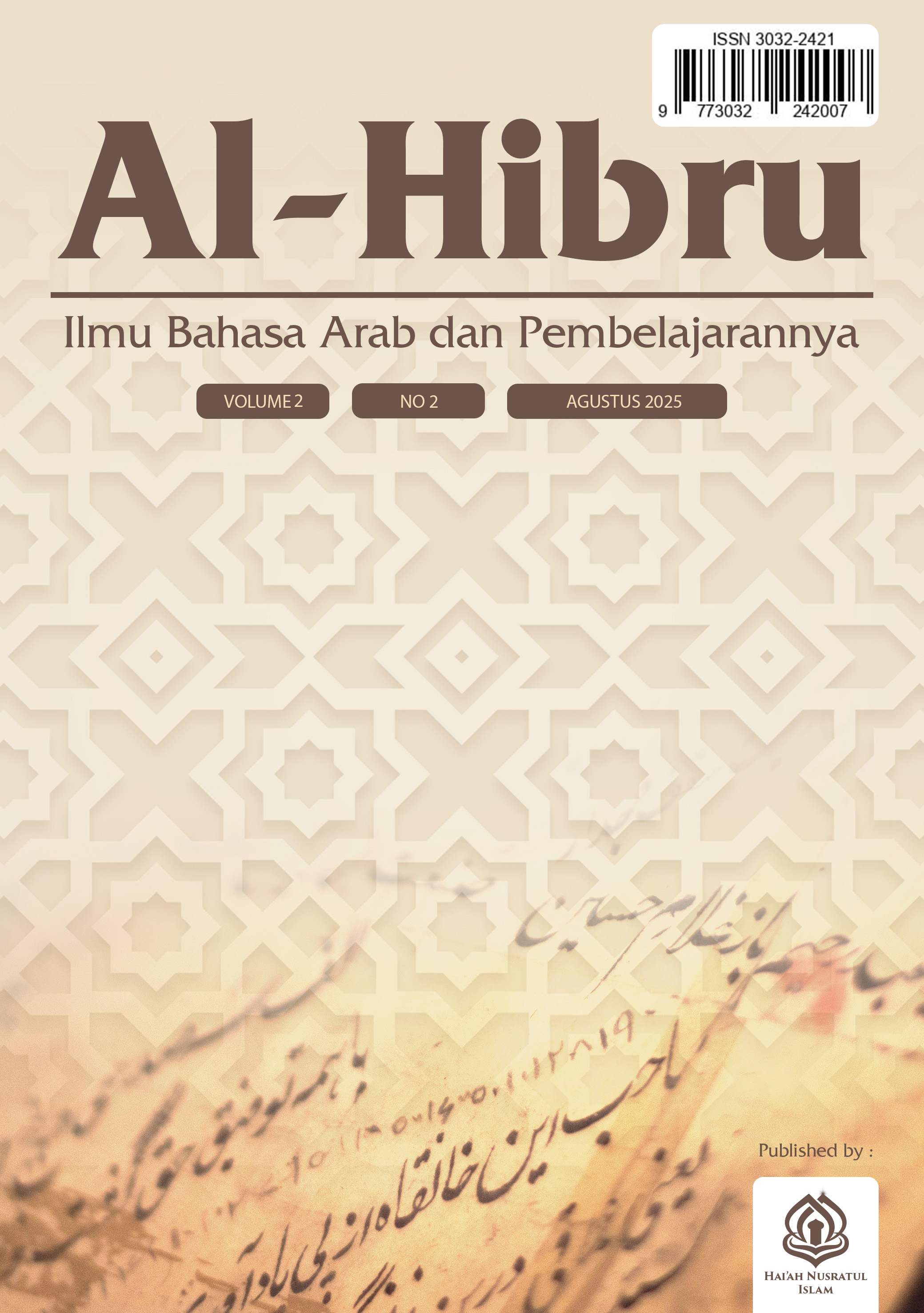TRANSLATING AND ANALYZING TRANSLATION METHODS, APPROACHES, AND TECHNIQUES IN STORIES “AL-ASADU WAL FA’RU”
DOI:
https://doi.org/10.59548/hbr.v2i2.394Keywords:
Translation, Method, Translation Technique, ApproachAbstract
This journal discusses the process of translating a classic Arabic fable story entitled Al-Asadu Wal Fa’ru (The Lion and the Mouse) into Indonesian. This story is a type of narrative fiction that contains moral values with animal characters that represent human nature and behavior. This study aims to identify and analyze the methods, approaches, processes, and techniques used in translating the text. The focus of the analysis is directed at the entire content of the story to understand how moral messages and narrative structures in the source language can be effectively transferred into the target language without losing meaning and cultural nuances. The results of the study show that the translation method applied in this text is a communicative method, which attempts to convey messages clearly and easily understood by the target reader. The most dominant technique used is the common equivalence technique, which prioritizes the use of equivalent words or expressions that are often used in Indonesian. In terms of ideological approach, this translation tends to use a domestication approach, namely adjusting elements of foreign culture so that they feel familiar and acceptable to local readers. Thus, it is hoped that this research can provide a useful contribution in the application of translation theories, especially in translating classical Arabic literary narrative texts, as well as increasing understanding in developing translator competence in the fields of Arabic literature and language.
References
As Salafy, T. (2021). Teknik, metode dan ideologi penerjemahan Arab-Indonesia dalam terjemahan buku Manzhumah Al-Qawāid Al-Fiqhiyyah karya Syeikh Abdurrahman Bin Nashir As-Sa’Diy. Uktub: Journal of Arabic Studies, 1(2), 113. https://doi.org/10.32678/uktub.v1i2.5816
Ethelb, H. (2019). Thematic analysis in translating English and Arabic scientific texts. Advances in Language and Literary Studies, 10(4), 88. https://doi.org/10.7575/aiac.alls.v.10n.4p.88
Hasyim, M. S. (2021). Al-taraduf (sinonim) dan kaidah penerapannya dalam al-Qur’an. Rausyan Fikr: Jurnal Studi Ilmu Ushuluddin dan Filsafat, 17(2), 179–201. https://doi.org/10.24239/rsy.v17i2.778
Hidayatullah, R. (2021). Peran konteks dalam studi makna: Kajian semantik Arab. JILSA (Jurnal Ilmu Linguistik Sastra Arab), 5(2), 184–197. https://doi.org/10.15642/jilsa.2021.5.2.184-197
Istiqomah, S. N., Nurhaliza, T. N., Nafis, Z., & Supriadi, R. (2023). Teknik penerjemahan bahasa Arab ke bahasa Indonesia. Aphorisme: Journal of Arabic Language, Literature, and Education, 4(2), 183–194. https://doi.org/10.37680/aphorisme.v4i2.4500
Izzah, N., Mushodiq, M. A., & Syaifullah, M. (2021). Semantics of lexicology in the study of Arabic phonemes and lexemes. Mantiqu Tayr: Journal of Arabic Language, 1(1), 71–84. https://doi.org/10.25217/mantiqutayr.v1i1.1327
Khoirurrijal, K., Arifi, A., Susilawati, A., & Wulandari, N. (2019). Interpretasi makna (prosedur penerjemahan Arab - Indonesia). Metrouniv Press & Idea Press Yogyakarta.
Khoshaba, L. M. (2021). Problems of translating English idiomatic expressions into Arabic. Qalaai Zanist Scientific Journal, 6(4), 1001–1012. https://doi.org/10.25212/lfu.qzj.6.4.37
Kustina, K., Shodiq, M. J., Syaifullah, M., & Surohman, I. (2024). The intercultural aspect of teaching Arabic as a foreign language in Indonesia. Mantiqu Tayr: Journal of Arabic Language, 4(1), 76–80. https://doi.org/10.25217/mantiqutayr.v4i1.4086
Mahsun. (2017). Metode penelitian bahasa: Tahapan, strategi, metode, dan tekniknya. Raja Grafindo Persada.
Mansur, A. A. (2018). Kontribusi pragmatik dalam penerjemahan: Peranan dan fungsi praktis. Diglossia: Jurnal Kajian Ilmiah Kebahasaan dan Kesusastraan, 9(2), 97. https://doi.org/10.26594/diglossia.v9i2.1140
Margareth, L. M., Sugono, D., & Suendarti, M. (2022). Analisis kesalahan berbahasa dalam pemberian komentar di media sosial Instagram (kajian psikolinguistik). Diskursus: Jurnal Pendidikan Bahasa Indonesia, 5(2), 125. https://doi.org/10.30998/diskursus.v5i2.12209
Matsna. (2016). Kajian semantik Arab. Kencana.
Muhassin, M. (2017). Telaah linguistik interdisipliner dalam makrolinguistik. English Education: Jurnal Tadris Bahasa Inggris, 6(1), 1–20. https://doi.org/10.24042/eejtbi.v6i1.516
Perdana, D. H. (2017). Strategi penerjemahan bahasa Arab yang berterima dan mudah dipahami. Lingua Scientia, 9(1), 146. https://doi.org/10.21274/ls.2017.9.1.140-15
Rachmawati, R. (2014). Aspek linguistik dan keberterimaan dalam penerjemahan. Madah, 5(1), 1–23. https://doi.org/10.26499/madah.v5i1.527
Rachmawati, R., & Syahid, A. H. (2024). Sinonim kata bahasa Arab dari terjemah buku Alfu Lailah wa Lailah. Mantiqu Tayr: Journal of Arabic Language, 4(2), 443–444. E-ISSN: 2774-6372
Rasyidi, L. M. R. F., et al. (2024). Perbedaan penerjemahan gramatikal bahasa Arab dan bahasa Indonesia. Jurnal Edukasi, 1(3), 316–324. https://doi.org/10.60132/edu.v1i3.184
Sari, V. I. S., Ayu, I., Purnami, N. P. M., & Yanti, J. B. M. E. (2024). Dimensi pemaknaan budaya pada prinsip kesopanan tindak tutur dalam percakapan melalui aplikasi chatting. Kulturistik: Jurnal Ilmu Bahasa dan Budaya, 8(1), 101–107. https://doi.org/10.22225/kulturistik.8.1.8677
Suo, X. (2015). A new perspective on literary translation strategies based on Skopos theory. Theory and Practice in Language Studies, 5(1), 176. https://doi.org/10.17507/tpls.0501.24
Tumbole, G. F. F., & Cholsy, H. (2022). Strategi penerjemahan kata sapaan dengan konteks sosial dan budaya dalam novel Bumi Manusia terjemahan bahasa Inggris. Diglossia: Jurnal Kajian Bahasa, Sastra, dan Pengajarannya, 5(3), 589–602. https://doi.org/10.30872/diglossia.v5i3.432
Umam, A. H. (2018). Keberterimaan antara teks sumber dan teks sasaran. Wanastra, 10(2), 47–54. https://doi.org/10.31294/w.v10i2.3901
Umam, M. K. (2021). Google Translate in tarjamah learning at Arabic language education UIN Walisongo Semarang. Mantiqu Tayr: Journal of Arabic Language, 1(1), 61–70. https://doi.org/10.25217/mantiqutayr.v1i1.1279
Wang, F. (2014). The application of thematic theory in translation. Theory and Practice in Language Studies, 4(4), 778–785. https://doi.org/10.4304/tpls.4.4.778-785
Wahab Rosyidi, A. (2007). Peran makna dalam penerjemahan. Jurnal Lingua, 2(1), 70–85. https://doi.org/10.18860/ling.v2i1.559
Yusniaty Galingging. (2021). Kolokasi dalam penerjemahan. Dialektika: Jurnal Bahasa, Sastra dan Budaya, 8(2), 1. https://doi.org/10.33541/dia.v8i2
Downloads
Published
How to Cite
Issue
Section
License
Copyright (c) 2025 Rahma Padilillah, Nuryatul Janah, Muhammad Awalludin

This work is licensed under a Creative Commons Attribution 4.0 International License.
- Share — copy and redistribute the material in any medium or format for any purpose, even commercially.
- Adapt — remix, transform, and build upon the material for any purpose, even commercially.
- The licensor cannot revoke these freedoms as long as you follow the license terms.
Under the following terms:
- Attribution — You must give appropriate credit , provide a link to the license, and indicate if changes were made . You may do so in any reasonable manner, but not in any way that suggests the licensor endorses you or your use.
- No additional restrictions — You may not apply legal terms or technological measures that legally restrict others from doing anything the license permits.
Notices:
You do not have to comply with the license for elements of the material in the public domain or where your use is permitted by an applicable exception or limitation .
No warranties are given. The license may not give you all of the permissions necessary for your intended use. For example, other rights such as publicity, privacy, or moral rights may limit how you use the material.













